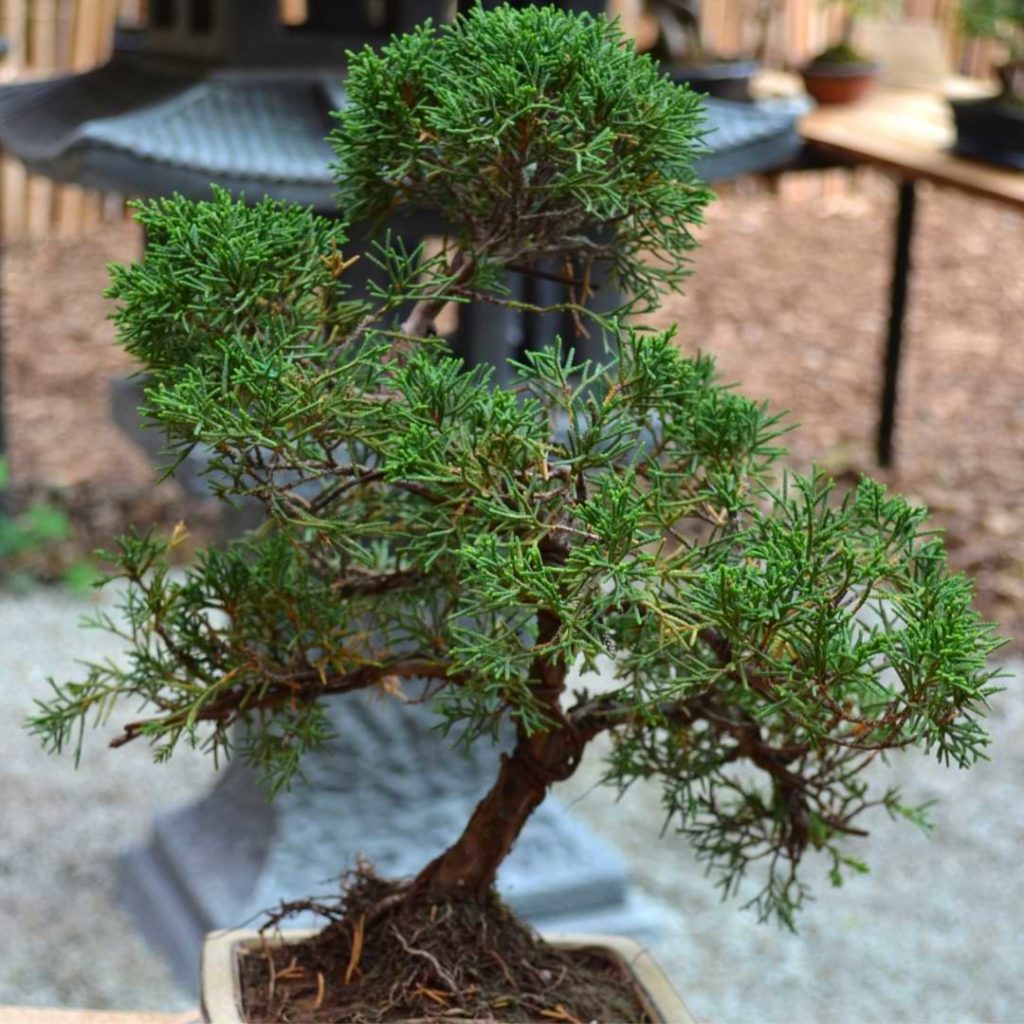Picea Mariana Bonsai
Looking for a beautiful bonsai specimen? Picea mariana, commonly known as black spruce, might be exactly what you’re looking for.
Although black spruce can be difficult to style as bonsai, these plants are popular bonsai nonetheless. The plant is slow-growing and requires limited day-to-day maintenance. Plus, spruce looks very attractive as bonsai and is fairly easy to acquire. Therefore, spruce bonsai is common despite being challenging to style.
Don’t let the challenge deter you from enjoying Picea mariana bonsai. Many bonsai lovers are able to keep this attractive bonsai in their collections. It probably shouldn’t be the first choice for a beginner, but if you have some experience with bonsai, you can have success with black spruce.
Position
Like most evergreens, Picea mariana thrives in full to partial sun during the summer months. This spruce does best with full sun with some shade during the hottest point of the day. During the winter, Picea mariana prefers more shade.
Although spruce is hardy to -10 degrees Fahrenheit, you will want to protect the roots during the winter. Pots do not provide the same amount of insulation that the ground would provide during this time.
Because spruce is an evergreen, it does not go dormant during the winter. It is important that the roots do not freeze and are able to continue providing water to the rest of the bonsai tree. Picea mariana is wind tolerant, so you do not have to worry about protecting your plant from cold, strong winds during the winter months.
Temperature
Black spruce trees are cool-temperature bonsai. In the natural environment, black spruce trees grow in areas with long, cold winters and short summers. Unlike some other bonsai, they do not normally need to be taken out of the cold during the winter. During extreme temperature drops, you might want to take young Picea mariana into an unheated space that offers protection from frost; but in most climates, your bonsai should be able to withstand winter temperatures just fine.
If you live in a warm climate, you may not be able to successfully keep Picea mariana bonsai. Black spruce do not like temperatures to climb above 80 degrees Fahrenheit for long periods of time. Although providing shade during the midpoint of summer days can help somewhat, do not expect to keep Picea mariana bonsai alive if the temperature regularly stays above 90 degrees Fahrenheit for weeks and weeks during the summer.
If you are in a region where it gets ridiculously hot often, pick a different type of spruce bonsai. We’ll talk about some of the other options a bit more below.
Soil
When it comes to soil, Picea mariana bonsai are not overly picky. They need soil that drains well, but they do not need it to have any other special qualities. Even the pH level does not matter too much to these plants.
How Often Do You Water Picea Mariana Bonsai Trees?
There is no set schedule for watering Picea mariana bonsai; however, you should water whenever the soil becomes dry. This will differ from plant to plant depending on environmental conditions.
You don’t need to constantly soak the soil, but black spruce does need to be watered frequently, especially during the summer. During the winter, you won’t need to water as often.
The best way to tell if it’s time to water is to use your finger to feel the soil. Stick your finger 2 inches into the soil near the plant. If the soil is dry, it’s time to water. If the soil is wet, you should wait longer until watering. It sounds simple, but this really is the best way to know if it’s time to water your black spruce bonsai.
When to Fertilize Picea Mariana Bonsai Plant
Fertilizing is important for bonsai because they do not have access to the same range of nutrients that their native counterparts do. I normally recommend a balanced fertilizer (where the NPK levels are equal) for most bonsai, but spruce can really benefit from a fertilizer with a higher amount of nitrogen, which helps to promote foliage growth.
I’d suggest fertilizing sparingly; you can always add more fertilizer if needed, but too much fertilizer can harm your plants, and there’s no easy way to get rid of it if you accidentally add too much.
Consider using a liquid bonsai plant food for your Picea mariana bonsai. Fertilize once every two weeks from spring until autumn. You may need to stop fertilizing for several weeks during the hottest part of the summer, but you can pick up fertilizing once the temperatures cool off some.
Even though spruce are evergreen, you do not need to continue fertilizing throughout the winter.
When to Repot Picea Mariana Bonsai
Bonsai periodically need to be repotted. For young Picea mariana, you can expect to need to repot every 2 to 4 years depending on the rate of growth. More mature bonsai need to be repotted less often; so as your Picea mariana plant ages, you will only need to repot about once every 5 years.
The best time to repot Picea mariana is during the spring. When you repot, you can trim away up to one-third of the roots. You may or may not need to pot up (or move the plant to a larger pot) depending on how much growth has occurred. Spruce generally have large root balls, so plan to use a deep container in order to give them enough room.
Of course, you should always repot using fresh soil regardless of whether or not you need to pot up. You’ll also want to shade your plant from full sun for a couple of weeks after repotting.
How Do You Bonsai Picea Mariana?
Because spruce bonsai are fairly low-maintenance and slow-growing, you might think that they are the perfect beginner bonsai plant. Unfortunately, they are somewhat tricky to style, which makes Picea mariana better for those who have some prior bonsai experience.
That being said, spruce makes extremely attractive bonsai, so it is worth learning how to style them.
Picea Mariana Bonsai Styling
Black spruce looks good in almost all bonsai styles. The one exception is broom. The styles that look the best are straight-trunk, curved trunk, windswept, and multi-trunk.
Wiring is somewhat tricky because it can only be done during the fall and winter. Using wires during the spring or summer can cause branches to die. Spruce branches are supple and can be easily shaped using wires. However, they sometimes return to their original shape once the wiring is removed before the spring.
Styling nursery spruce can be especially difficult. You’ll have more success if you buy spruce plants that have been grown with the intention of being displayed as bonsai. This will give you a better foundation to work with.
Pruning and Trimming
Even though black spruce are slow-growing bonsai, they still require pruning and trimming to keep their bonsai shape. This process can also be a little tricky.
Picea mariana has whorled growth, meaning that several branches grow at the same height on the tree. You should remove all of the whorl except for one branch on the bottom half of the tree. This means that you need to pinch the extra branches in the spring while the growth is still new and soft.
Any major pruning that needs to be done should happen in the fall. You’ll need to be careful and plan ahead, though. Spruce does not back-bud on old wood. If you are not thinking ahead, you may end up with bare branches on your bonsai.
Other Spruce That Bonsai Well
Black spruce is a popular choice for bonsai. Dwarf black spruce (Picea mariana ‘Nana’) is especially sought after due to its gray-green needles that grow to about ½ inch in length. However, not everyone has the correct climate for this beautiful specimen.
If you regularly have weather over 90 degrees Fahrenheit during the summer, then you won’t have success with black spruce. But don’t worry, there are some other attractive spruce options available.
Here are other species of spruce that may work better for you.
Picea abies: Also known as Norway spruce, this tree is probably what springs to mind when you think of a Christmas tree. This species is hardy through zone 7A, so it will grow in areas that are too warm for other types of spruce.
Picea abies ‘Pygmaea’: This variety is a pygmy Norway spruce. It’s another good option for those in warmer climates.
Picea glauca conica: White spruce is hardy in zones 4-6. It’s a popular bonsai option that can withstand heat and drought fairly well for spruce. White spruce has lots of problems with spider mite infestations, so watch out for them!
So there are several spruce options for those of us who prefer to live in places without long, cold winters. However, if you have no winter at all (AKA, you can regularly wear flip-flops throughout December and January), then you might not be able to keep spruce bonsai alive. You probably have plenty of other plants that no one else can grow though.
Picea Mariana Bonsai FAQ
Can spruce bonsai grow inside?
Indoor temperatures are likely to be too warm for spruce bonsai. Black spruce need long, cold winters, so it’s unlikely that you’re going to be able to provide that kind of environment inside. However, if you have a spruce that can handle warmer temperatures, like a Norway spruce, you can bring it inside for a couple of days at Christmastime for decoration. Mostly, though, you should keep your spruce bonsai outdoors.
Is spruce good for bonsai?
Spruce can be a bit tricky to style as bonsai, but that does not keep spruce from being a popular choice for bonsai. Spruce grows slowly and does not require much daily maintenance.
Does Picea back-bud?
Picea mariana does not commonly back-bud on old growth. Keep this in mind when you are trimming your bonsai and planning for new growth; otherwise, you could end up with a bonsai that looks more sparse than usually desired.
What pests are attracted to black spruce?
Like many spruce trees, black spruce bonsai can have issues with spider mites during the summer. Spider mites, which can quickly destroy a bonsai tree, can be difficult to notice at first, and even harder to get rid of once they have a few cycles to reproduce.
Prevent spider mites in the first place by regularly spraying water on your bonsai’s foliage during hot weather. There are two natural options for dealing with spider mites once they have attacked your bonsai: the first option is to use neem oil, and the second option is to attract ladybugs, a predator of spider mites.
If these options fail, you might have to resort to commercial chemical options. Since spider mites reproduce quickly, they can become resistant to common chemical solutions. If you do not get rid of all of the spider mites in two or three applications, you’ll need to switch to something else because most of the spider mites left will have an immunity to that chemical after several reproductive cycles.
Have another question about caring for your Picea mariana bonsai plant? Join the conversation in our Facebook group.
Bonsai With Us!
The Bonsai Resource Center is here to help you learn about hinoki cypress bonsai and provide you with the tools you need to keep your plant healthy and strong. Explore our other articles, visit our online shop, and connect with other bonsai lovers in our Facebook group to learn everything you need to know about this rewarding hobby!



